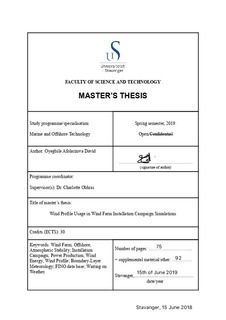| dc.contributor.advisor | Obhrai, Charlotte | |
| dc.contributor.author | Oyegbile, Afolarinwa | |
| dc.date.accessioned | 2019-10-09T09:09:46Z | |
| dc.date.available | 2019-10-09T09:09:46Z | |
| dc.date.issued | 2019-06-15 | |
| dc.identifier.uri | http://hdl.handle.net/11250/2621099 | |
| dc.description | Master's thesis in Offshore Technology | nb_NO |
| dc.description.abstract | Simulation tools are used in the wind industry to analyse and understand installation campaigns for strategic planning purposes. These tools use vertical wind profiles to estimate wind speeds at various heights. Where these wind speeds are limiting criteria for marine operations offshore, the wind profile used is of utmost importance for waiting on weather; one of the major cost and risk drivers in wind projects, especially offshore. This study investigates the impact the wind profile used in these simulation tools can have on the results obtained. 9 years of weather data obtained from the FINO3 platform and the reference height used to extrapolate the wind speed was 30 m. The atmospheric conditions at the site were assessed and also, the accuracy of different wind extrapolation model (A power law wind profile with an exponent of 0.12 and 0.14, the logarithmic wind profile with and without stability correction and the extended wind profile proposed by Gryning) were evaluated. The results showed that for all stability conditions, the extended wind profile performs either as well as the other wind profiles considered in this study for unstable conditions. Except for near neutral unstable conditions where the power law wind profile with an exponent of 0.12 performs better. During stable conditions, it performs significantly better.
Analyses were carried out based on the various wind weather windows required for offshore installation campaign defined in this study. It was found that the data from the power law wind profile (both) underestimated the number of available wind weather wind for the various installation operations. Compared to that of the measured data underestimation of up approximately 17% and 23% were obtained for the power law wind profile with an exponent of 0.12 and 0.14 respectively. False wind weather windows were also predicted due to the large underestimations of the wind speed at the hub heights during stable conditions. While when using the data from extended wind profile the number of available windows for installation operations with a wind speed limit less than 14 m/s was overestimated. Overestimation of up to 8% was observed. For the other required wind weather windows (i.e .installation operation with wind speed limit equals or greater than 14 m/s), the number of available wind weather windows appeared to closely match that of the measured data (the accuracy in estimating the number of available wind weather windows range from 0.5% to 1.22%). Based on these findings, a new approach to wind profile modelling in wind farm installation campaign simulations using the extended wind profile is suggested. The new approach with a compensation factor of 0.25 m/s had an accuracy within ±1% when estimating the number of available weather windows.
The impact the wind profile model adopted will have on the accumulated waiting on weather during installation campaign and possible power production is also assessed. The results show that atmospheric stability clearly affects the accumulated waiting on weather during offshore wind farm campaign simulation, and should be considered when simulations involving the installation phase of a wind farm project are involved. A better estimation of the possible power production is also achieved when atmospheric stability is accounted for. | nb_NO |
| dc.language.iso | eng | nb_NO |
| dc.publisher | University of Stavanger, Norway | nb_NO |
| dc.relation.ispartofseries | Masteroppgave/UIS-TN-IMBM/2019; | |
| dc.subject | offshore | nb_NO |
| dc.subject | atmospheric stability | nb_NO |
| dc.subject | installation campaign | nb_NO |
| dc.subject | power production | nb_NO |
| dc.subject | wind energy | nb_NO |
| dc.subject | wind profile | nb_NO |
| dc.subject | boundary-layer meteorology | nb_NO |
| dc.subject | FINO | nb_NO |
| dc.subject | waiting on weather | nb_NO |
| dc.subject | vindkraft | nb_NO |
| dc.subject | wind farm | nb_NO |
| dc.subject | offshore teknologi | nb_NO |
| dc.title | Wind Profile Usage in Wind Farm Installation Campaign Simulations | nb_NO |
| dc.type | Master thesis | nb_NO |
| dc.subject.nsi | VDP::Technology: 500::Marine technology: 580::Offshore technology: 581 | nb_NO |
